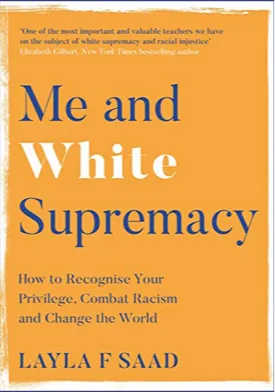Me and White Supremacy: How to Recognise Your Privilege, Combat Racism and Change the World by Layla Saad
In her book Me and White Supremacy, author Layla Saad provides a clear and honest look at how white supremacy is communicated through people today and offers readers a blueprint for recognizing and challenging their own beliefs and behaviors. Saad’s book works to educate and empower readers to take action to become more accountable and actively dismantle racist systems. Drawing from her own story as well as many other experiences, Saad engages her readers with an expanded idea of white supremacy.
Me and White Supremacy discusses the importance of being proactive in understanding white privilege and how to use it to work against racism. Saad strongly believes that “being silent about issues of race and racism is a luxury that some of us cannot afford.” She encourages her readers to be aware of how their privilege affects their lives even if they don’t desire or intend to be privileged. Saad has built exercises in both the book and its companion journal to help readers understand how to recognize and challenge white privilege in their lives.
The first step in this process is understanding the definition of white supremacy, which Saad states as “a system of power, privilege, and domination based on the idea that whites are better than people of color.” She also touches on the need to break away from the narrative that white supremacy is only reinforced by extreme and obvious acts of racism. Through examples, layering in of history, and interactive paths to exploration, Saad takes an honest and considered look at white supremacy in our various systems and institutions.
The second step in the process is allowing readers to identify and acknowledge the ways in which they are complicit and taking action to work against them. Saad goes into some detail on how to “learn what actual antiracism looks like: Dismantling systems, institutions, and beliefs that benefit one race at the expense of another.” She offers an unflinching look at examining why certain groups benefit from certain privilege and where unequal and oppressive power structures come from.
Finally, Saad discusses what it means to actively work for equity and the importance of taking steps to become an anti-racist. She provides a framework through which readers can “develop and apply an authenticity ethic in their lives and work for greater alignment with their ideals.” This includes interacting with others, showing genuine respect for people’s cultural practices, deepening an understanding of intersectional identities, and deepening relationships with communities that are marginalized.
Overall, Me and White Supremacy is an invaluable resource for anyone who wants to understand and actively combat racism. By addressing systemic issues, Saad forces readers to confront their own complicity in it, allowing them to think more deeply about racism and its implications. It is a must-read for those of all backgrounds and a great place to start when looking for ways to make change and work for a more just world.

